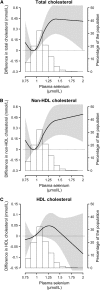Higher selenium status is associated with adverse blood lipid profile in British adults
- PMID: 19906812
- PMCID: PMC2793123
- DOI: 10.3945/jn.109.111252
Higher selenium status is associated with adverse blood lipid profile in British adults
Abstract
Recent findings have raised concern about possible associations of high selenium exposure with diabetes and hyperlipidemia in the US, a population with high selenium status. In the UK, a population with lower selenium status, there is little data on the association of selenium status with cardio-metabolic risk factors in the general population. We examined the association of plasma selenium concentration with blood lipids in a nationally representative sample of British adults. A cross-sectional study was conducted among 1042 white participants (aged 19-64 y) in the 2000-2001 UK National Diet and Nutrition Survey. Plasma selenium was measured by inductively coupled-plasma mass spectrometry. Total and HDL cholesterol were measured in nonfasting plasma samples. Mean plasma selenium concentration was 1.10 +/- 0.19 micromol/L. The multivariate adjusted differences between the highest (> or =1.20 micromol/L) and lowest (<0.98 micromol/L) quartiles of plasma selenium were 0.39 (95% CI 0.18, 0.60) mmol/L for total cholesterol, 0.38 (0.17, 0.59) for non-HDL cholesterol, and 0.01 (-0.05, 0.07) for HDL cholesterol. Higher plasma selenium (i.e., > or =1.20 micromol/L) was associated with increased total and non-HDL cholesterol levels but not with HDL in the UK adult population. These findings raise additional concern about potential adverse cardio-metabolic effects of high selenium status. Randomized and mechanistic evidence is necessary to assess causality and to evaluate the impact of this association on cardiovascular risk.
Figures

Similar articles
-
Anthropometric indices and selenium status in British adults: the U.K. National Diet and Nutrition Survey.Free Radic Biol Med. 2013 Dec;65:1315-1321. doi: 10.1016/j.freeradbiomed.2013.09.025. Epub 2013 Oct 4. Free Radic Biol Med. 2013. PMID: 24095852
-
Serum selenium and serum lipids in US adults: National Health and Nutrition Examination Survey (NHANES) 2003-2004.Atherosclerosis. 2010 Jun;210(2):643-8. doi: 10.1016/j.atherosclerosis.2010.01.005. Epub 2010 Jan 11. Atherosclerosis. 2010. PMID: 20102763 Free PMC article.
-
Serum selenium and serum lipids in US adults.Am J Clin Nutr. 2008 Aug;88(2):416-23. doi: 10.1093/ajcn/88.2.416. Am J Clin Nutr. 2008. PMID: 18689378 Free PMC article.
-
Life-style and serum lipids and lipoproteins.J Atheroscler Thromb. 2000;7(4):177-97. doi: 10.5551/jat1994.7.177. J Atheroscler Thromb. 2000. PMID: 11521681 Review.
-
Nonfasting versus fasting lipid profile for cardiovascular risk prediction.Pathology. 2019 Feb;51(2):131-141. doi: 10.1016/j.pathol.2018.09.062. Epub 2018 Dec 3. Pathology. 2019. PMID: 30522787 Review.
Cited by
-
Association between composite dietary antioxidant index and hyperlipidemia: a cross-sectional study from NHANES (2005-2020).Sci Rep. 2024 Jul 10;14(1):15935. doi: 10.1038/s41598-024-66922-0. Sci Rep. 2024. PMID: 38987566 Free PMC article.
-
Dietary selenium intake in relation to non-alcoholic fatty liver disease assessed by fatty liver index and hepatic steatosis index; a cross-sectional study on the baseline data of prospective PERSIAN Kavar cohort study.BMC Endocr Disord. 2023 Mar 3;23(1):51. doi: 10.1186/s12902-023-01307-4. BMC Endocr Disord. 2023. PMID: 36864425 Free PMC article.
-
The association of selenium exposure with the odds of metabolic syndrome: a dose-response meta-analysis.BMC Endocr Disord. 2025 Feb 25;25(1):49. doi: 10.1186/s12902-025-01858-8. BMC Endocr Disord. 2025. PMID: 39994710 Free PMC article.
-
Relatively high mortality risk in elderly Swedish subjects with low selenium status.Eur J Clin Nutr. 2016 Jan;70(1):91-6. doi: 10.1038/ejcn.2015.92. Epub 2015 Jun 24. Eur J Clin Nutr. 2016. PMID: 26105108 Free PMC article.
-
A single consumption of high amounts of the Brazil nuts improves lipid profile of healthy volunteers.J Nutr Metab. 2013;2013:653185. doi: 10.1155/2013/653185. Epub 2013 Jun 11. J Nutr Metab. 2013. PMID: 23840948 Free PMC article.
References
-
- Navas-Acien A, Bleys J, Guallar E. Selenium intake and cardiovascular risk - what is new? Curr Opin Lipidol. 2008;19:43–9. - PubMed
-
- Rayman MP. Food-chain selenium and human health: emphasis on intake. Br J Nutr. 2008;100:254–68. - PubMed
-
- Burk RF. Selenium, an antioxidant nutrient. Nutr Clin Care. 2002;5:75–9. - PubMed
-
- Papp LV, Lu J, Holmgren A, Khanna KK. From selenium to selenoproteins: synthesis, identity, and their role in human health. Antioxid Redox Signal. 2007;9:775–806. - PubMed
-
- Bleys J, Navas-Acien A, Guallar E. Serum selenium and diabetes in U.S. Adults. Diabetes Care. 2007;30:829–34. - PubMed

